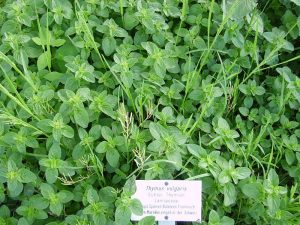The first consideration in how to grow medicinal herbs is to match the site characteristics to the selection of plants that will grow best in the local climate, soil and light conditions. Some gardeners prefer a raised bed system which elevates the garden bed 8” or so above the ground surface. While this method requires a high amount of work initially, it allows easy access for mulching and hand weeding, prevents soil compression from walking on soil, and eliminates the need to routinely till and disturb the soil. Others prefer a standard row method, using either tilling or mulching between the rows to control weeds and moisture content. In any case, permanent walkways should be established to prevent compaction of the soil around the plant roots.
For those who cannot bend or stoop, a patio garden can be constructed, with an 8-12” deep planting bed with drainage holes on a sturdy bench at hip or wheelchair height. Plants can be grown in individual pots or directly in soil in the bed. In either case, care needs to be taken that the soil is loose, the base tray can be drained, and individual containers will fully drain so the plant roots are never kept in saturated soil for more than an hour or so. Especially in hard water regions, it is best to water potted plants from trays at the roots, as mineral salts will accumulate in the soil and kill the plant
Herbs Soil Preparation in How to Grow Medicinal Herbs

Once the soil has been analyzed, amend the soil using natural materials to create a compost mix that is slow releasing and will maintain plant growth over a long period of time. Garden soil should drain quickly and yet retain moisture; it should be easy to make a hole in the soil with a hand. If not, mix sand into the top 12 inches of the garden. Be sure that the sand is not contaminated by agricultural chemicals as is often the case with sand that is taken from rivers or agricultural areas. Contaminated sand or compost materials will kill the valuable mycorrhiza in the soil. A cubic yard of sand will cover 54 square feet to a depth of six inches, to be tilled or spaded into the soil bed.
Most plants prefer a slightly acid pH; about 6.3 -6.8, where the solubility of most essential nutrients is highest. Outside the range of 6.3-6.8, most major plant nutrient minerals become insoluble and unavailable for uptake by plant roots. To raise the pH of a soil that is too acid, add natural calcium carbonate, usually as limestone. To lower the pH of a soil that is too alkaline is more difficult; sulfur can be added, although the effects are short-term and the supplement tends to be expensive.
Composting
A good composting system maintains a healthy environment for the decomposers – bacteria, fungi, molds and other microorganisms that are essential for soil decomposition and healthy plant growth. The best environment for microorganisms is a ratio of carbon to nitrogen of 25-1 to 30-1. For instance, grass contains about 19-1; dry leaves about 55-1. An equal mix of each provides close to an ideal ratio. Materials with high carbon content include cereal straws, sawdust & wood chips, paper and cardboard (with soy inks). Materials with higher nitrogen content include wilted green material, animal manures, grass clippings, fruit and vegetable trimmings, skins and waste, such as kitchen compost (which should be free of meat and dairy products).
Organic compost can be purchased, or combine materials from a local home and garden store. Easily available materials include blood bone & fish meal, dried manure, rock potash, wood ash, & seaweed meal. For added effectiveness, add mycorrhiza to compost to promote the growth of soil microorganisms. Peat moss is not recommended due to the negative environmental impact of harvesting.
Fall is a good time to apply compost, followed with a winter mulch of materials such as straw, grass or newspaper that uses soy ink. If compost is added in the spring, it should be done a couple of weeks before planting to allow soil microorganisms to break down the nutrients, enriching the soil for the young plants. Never apply fresh manure as its fast release of nitrogen is detrimental to most microorganisms. Do not apply chicken or bat manure directly to the soil at any time as it is too high in phosphorous for mycorrhiza. Cow or horse manure that has been composted for several months is safe to add. Compost should not be worked into the soil during the growing season, as this will break up the soil mycorrhiza which is attached to and an extension of the plant roots.
Planting
Research each plant species for the specific requirements for germination and early development. Some sources will ship prepared seeds; other may provide viable roots for planting or ship already started plant plugs. Never remove wild plants from protected areas; many medicinal plant species are threatened or endangered due to loss of habitat and overharvesting.
Predation
Companion plants that discourage insect predation, some of which are considered to be “weeds”, include Marigold, Nasturtium, Asiatic Dayflower, Virginia Copperleaf, and Horsenettle. Insects love these plants and tend to prefer them. Healthy plants are more resistant to insects, but in the beginning, soil conditions may be far from ideal. To cope with insect predation while restoring the soil ecology, many gardeners prefer to use homemade bug sprays made from an oil/soap/garlic/water spray. Never use detergent soaps containing a degreaser, which will harm plants.
Thordur Sturluson
Latest posts by Thordur Sturluson (see all)
- What is the Difference Between Hemp and Marijuana? - June 3, 2019
Leave a Reply